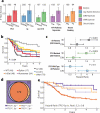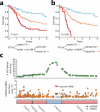Multi-tiered genomic analysis of head and neck cancer ties TP53 mutation to 3p loss
- PMID: 25086664
- PMCID: PMC4146706
- DOI: 10.1038/ng.3051
Multi-tiered genomic analysis of head and neck cancer ties TP53 mutation to 3p loss
Abstract
Head and neck squamous cell carcinoma (HNSCC) is characterized by aggressive behavior with a propensity for metastasis and recurrence. Here we report a comprehensive analysis of the molecular and clinical features of HNSCC that govern patient survival. We find that TP53 mutation is frequently accompanied by loss of chromosome 3p and that the combination of these events is associated with a surprising decrease in survival time (1.9 years versus >5 years for TP53 mutation alone). The TP53-3p interaction is specific to chromosome 3p and validates in HNSCC and pan-cancer cohorts. In human papillomavirus (HPV)-positive tumors, in which HPV inactivates TP53, 3p deletion is also common and is associated with poor outcomes. The TP53-3p event is modified by mir-548k expression, which decreases survival further, and is mutually exclusive with mutations affecting RAS signaling. Together, the identified markers underscore the molecular heterogeneity of HNSCC and enable a new multi-tiered classification of this disease.
Figures



Similar articles
-
Expression of SESN1, UHRF1BP1, and miR-377-3p as prognostic markers in mutated TP53 squamous cell carcinoma of the head and neck.Cancer Biol Ther. 2017 Oct 3;18(10):775-782. doi: 10.1080/15384047.2017.1373212. Epub 2017 Sep 8. Cancer Biol Ther. 2017. PMID: 28886272 Free PMC article. Review.
-
Combined TP53 mutation/3p loss correlates with decreased radiosensitivity and increased matrix-metalloproteinase activity in head and neck carcinoma.Oral Oncol. 2015 May;51(5):470-5. doi: 10.1016/j.oraloncology.2015.01.014. Epub 2015 Feb 27. Oral Oncol. 2015. PMID: 25735654 Free PMC article.
-
Specific TP53 mutations predict aggressive phenotype in head and neck squamous cell carcinoma: a retrospective archival study.Head Neck Oncol. 2011 Apr 22;3:20. doi: 10.1186/1758-3284-3-20. Head Neck Oncol. 2011. PMID: 21513535 Free PMC article.
-
Disruptive TP53 mutation is associated with aggressive disease characteristics in an orthotopic murine model of oral tongue cancer.Clin Cancer Res. 2011 Nov 1;17(21):6658-70. doi: 10.1158/1078-0432.CCR-11-0046. Epub 2011 Sep 8. Clin Cancer Res. 2011. PMID: 21903770 Free PMC article.
-
TP53 Mutations in Head and Neck Squamous Cell Carcinoma and Their Impact on Disease Progression and Treatment Response.J Cell Biochem. 2016 Dec;117(12):2682-2692. doi: 10.1002/jcb.25592. Epub 2016 Jun 3. J Cell Biochem. 2016. PMID: 27166782 Free PMC article. Review.
Cited by
-
Missense mutations in the TP53 DNA-binding domain predict outcomes in patients with advanced oral cavity squamous cell carcinoma.Oncotarget. 2016 Jul 12;7(28):44194-44210. doi: 10.18632/oncotarget.9925. Oncotarget. 2016. PMID: 27283772 Free PMC article.
-
Immune evasion in HPV- head and neck precancer-cancer transition is driven by an aneuploid switch involving chromosome 9p loss.Proc Natl Acad Sci U S A. 2021 May 11;118(19):e2022655118. doi: 10.1073/pnas.2022655118. Proc Natl Acad Sci U S A. 2021. PMID: 33952700 Free PMC article.
-
Periostin secreted by cancer-associated fibroblasts promotes cancer stemness in head and neck cancer by activating protein tyrosine kinase 7.Cell Death Dis. 2018 Oct 22;9(11):1082. doi: 10.1038/s41419-018-1116-6. Cell Death Dis. 2018. Retraction in: Cell Death Dis. 2024 Jan 15;15(1):54. doi: 10.1038/s41419-024-06445-8. PMID: 30348980 Free PMC article. Retracted.
-
Expression of SESN1, UHRF1BP1, and miR-377-3p as prognostic markers in mutated TP53 squamous cell carcinoma of the head and neck.Cancer Biol Ther. 2017 Oct 3;18(10):775-782. doi: 10.1080/15384047.2017.1373212. Epub 2017 Sep 8. Cancer Biol Ther. 2017. PMID: 28886272 Free PMC article. Review.
-
Emerging role of sphingosine-1-phosphate signaling in head and neck squamous cell carcinoma.Onco Targets Ther. 2016 May 31;9:3269-80. doi: 10.2147/OTT.S99989. eCollection 2016. Onco Targets Ther. 2016. PMID: 27330306 Free PMC article. Review.
References
Publication types
MeSH terms
Substances
Supplementary concepts
Grants and funding
- UL1 TR000005/TR/NCATS NIH HHS/United States
- P41 GM103504/GM/NIGMS NIH HHS/United States
- DP5 OD017937-01/OD/NIH HHS/United States
- R01 CA158448/CA/NCI NIH HHS/United States
- R01 EB014929/EB/NIBIB NIH HHS/United States
- P30 CA023100/CA/NCI NIH HHS/United States
- DP5 OD017937/OD/NIH HHS/United States
- P50 GM085764/GM/NIGMS NIH HHS/United States
- U24 CA184427/CA/NCI NIH HHS/United States
- P41 RR031228/RR/NCRR NIH HHS/United States
- K07 CA137140/CA/NCI NIH HHS/United States
- P50 CA097190/CA/NCI NIH HHS/United States
- T32 DC000028/DC/NIDCD NIH HHS/United States
LinkOut - more resources
Full Text Sources
Other Literature Sources
Medical
Research Materials
Miscellaneous

